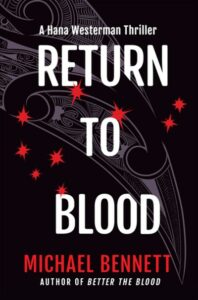Hana Westerman #2
 This is an interesting new series. In the first novel, New Zealand cop Hana Westerman took down a serial killer – and then walks away from the job. She’s not just a New Zealander, she’s a Māori. The Māori culture is infused into both books, lending them an interest and snap. She was conflicted in book one: is she a Māori, or is she a cop? Is she meant to enforce laws against her own people? In book two she’s back in the tiny seaside town where she grew up, living down the street from her father, Eru. Her daughter, Addison, and her roommate, PLUS 1, are back in Auckland living in Hana’s old place – and to Hana’s annoyance their new puppy is peeing all over her beloved garden.
This is an interesting new series. In the first novel, New Zealand cop Hana Westerman took down a serial killer – and then walks away from the job. She’s not just a New Zealander, she’s a Māori. The Māori culture is infused into both books, lending them an interest and snap. She was conflicted in book one: is she a Māori, or is she a cop? Is she meant to enforce laws against her own people? In book two she’s back in the tiny seaside town where she grew up, living down the street from her father, Eru. Her daughter, Addison, and her roommate, PLUS 1, are back in Auckland living in Hana’s old place – and to Hana’s annoyance their new puppy is peeing all over her beloved garden.
Hana is settling into her new life, running along the beach, teaching teens how to drive and pass the test they’ll take to get their license, and taking care of the Māori meeting house. However, when Addison and PLUS 1 come for a visit, they’re out on the beach one night, and Addison discovers some bones. This does two things: the bones, which are quickly identified, turn out to belong to a young woman about Addison’s age. This gets inside of Addison’s head and she can’t let go. Much like her daughter, the discovery also gets inside Hana’s head, and she is having the difficult experience of seeing her old colleagues run the case. She wants to help, but there’s only so far she can go before she’s shut out.
The life of the dead young woman is narrated by – herself, as we see flashbacks to her life as a junkie and sex worker who eventually found love and kicked her habit, then fell off with disastrous results. You can see the connection Addison feels to her and in her dreams she communicates with her. Addison is so intense she seeks out the dead girl’s boyfriend.
Hana’s intensity pushes her into investigative mode, and she unveils some evidence that she reluctantly shares with the police. She’s so conflicted, it’s obvious to the reader that she hasn’t quite figured out where she wants her life to land. She’s such a rich character. The author fleshes her out in interesting ways – she’s a precise thinker and uses her own drawings to record crime scenes or suspect’s faces. She’s a mother, a daughter, an aunt and a cousin whose family resents her for leaving town. She’s watching her father age. And through it all, Bennett draws in her Māori culture in an effortless manner.
Hana’s character is a major reason these aren’t run of the mill police procedurals. The story here could have come from the pen of any number of writers of police novels, and like the best of them, the setting, culture and personalities of the characters make the books sparkle. I actually thought this was a less cliched story than the first book, which is a serial killer story, but both books provide a propulsive read. I’m more than committed as a reader in finding out what choices Hana makes next. — Robin Agnew